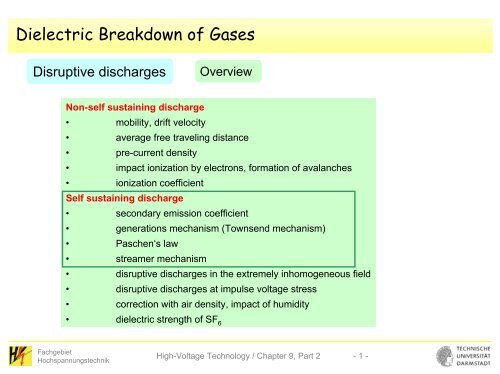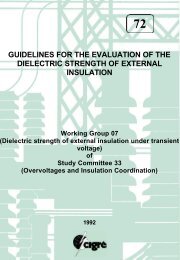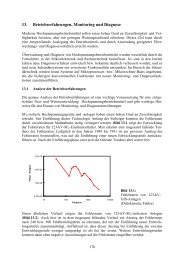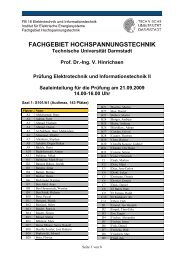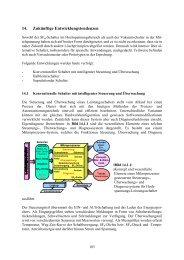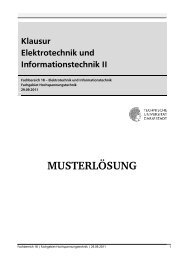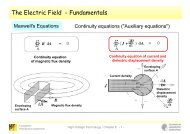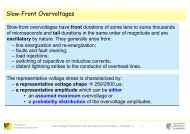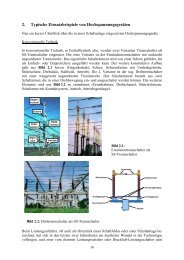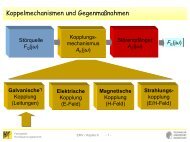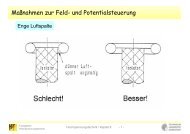Dielectric Breakdown of Gases - Fachgebiet Hochspannungstechnik
Dielectric Breakdown of Gases - Fachgebiet Hochspannungstechnik
Dielectric Breakdown of Gases - Fachgebiet Hochspannungstechnik
You also want an ePaper? Increase the reach of your titles
YUMPU automatically turns print PDFs into web optimized ePapers that Google loves.
<strong>Dielectric</strong> <strong>Breakdown</strong> <strong>of</strong> <strong>Gases</strong><br />
Disruptive discharges<br />
Overview<br />
Non-self sustaining discharge<br />
• mobility, drift velocity<br />
• average free traveling distance<br />
• pre-current density<br />
• impact ionization by electrons, formation <strong>of</strong> avalanches<br />
• ionization coefficient<br />
Self sustaining discharge<br />
• secondary emission coefficient<br />
• generations mechanism (Townsend mechanism)<br />
• Paschen‘s law<br />
• streamer mechanism<br />
• disruptive discharges in the extremely inhomogeneous field<br />
• disruptive discharges at impulse voltage stress<br />
• correction with air density, impact <strong>of</strong> humidity<br />
• dielectric strength <strong>of</strong> SF 6<br />
<strong>Fachgebiet</strong><br />
<strong>Hochspannungstechnik</strong><br />
High-Voltage Technology / Chapter 9, Part 2 - 1 -
<strong>Dielectric</strong> <strong>Breakdown</strong> <strong>of</strong> <strong>Gases</strong><br />
Secondary emission coefficient<br />
Therole<strong>of</strong> positive ions:<br />
• no contribution to ionization <strong>of</strong> the gas (energy too low!)<br />
but......<br />
release <strong>of</strong> free electrons from the metallic cathode surface<br />
necessary energy:<br />
Work function W a<br />
<strong>Fachgebiet</strong><br />
<strong>Hochspannungstechnik</strong><br />
High-Voltage Technology / Chapter 9, Part 2 - 2 -
<strong>Dielectric</strong> <strong>Breakdown</strong> <strong>of</strong> <strong>Gases</strong><br />
Secondary emission coefficient<br />
Element<br />
Work Function W a (eV)<br />
Cs 0.7 ... 1.9<br />
Al 1.8 ... 4<br />
Ag 3.0 ... 4.7<br />
Mo 3.2 ... 4.2<br />
Ni 3.7 ... 5<br />
Cu 3.9 ... 4.8<br />
Fe 3.9 ... 4.8<br />
Au 4.3 ... 4.9<br />
Cr 4.4<br />
W a<br />
≈ ¼ W i<br />
Order number Name<br />
Allocation <strong>of</strong> shells<br />
K ... N with electrons<br />
K L M N<br />
1 Hydrogen (H) 1<br />
2 Helium (He) 2<br />
3 Lithium (Li) 2 1<br />
4 Beryllium (Be) 2 2<br />
5 Boron (B) 2 3<br />
6 Carbon (C) 2 4<br />
7 Nitrogen (N) 2 5<br />
8 Oxygen (O) 2 6<br />
9 Fluor (F) 2 7<br />
10 Neon (Ne) 2 8<br />
11 Sodium (Na) 2 8 1<br />
12 Magnesium (Mg) 2 8 2<br />
13 Aluminum (Al) 2 8 3<br />
14 Silicon (Si) 2 8 4<br />
15 Phosphorus (P) 2 8 5<br />
16 Sulfur (S) 2 8 6<br />
17 Chlorine (Cl) 2 8 7<br />
18 Argon (Ar) 2 8 8<br />
19 Pottassium (K) 2 8 8 1<br />
20 Calcium (Ca) 2 8 8 2<br />
1 st ionization energy<br />
(eV)<br />
1 st activation energy<br />
(eV)<br />
Remark<br />
13.6 10.2<br />
24.59 19 inert gas<br />
5.39<br />
9.32<br />
8.3<br />
11.26<br />
14.53 6.3 (for N 2 )<br />
13.62 7.9 (for O 2 ) electronegative<br />
17.42 Fluor (F) electronegative<br />
21.56 16.6 inert gas<br />
5.14<br />
7.65<br />
5.99<br />
8.15<br />
10.49<br />
10.36<br />
12.97 electronegative<br />
15.76 inert gas<br />
4.34<br />
6.11<br />
<strong>Fachgebiet</strong><br />
<strong>Hochspannungstechnik</strong><br />
High-Voltage Technology / Chapter 9, Part 2 - 3 -
<strong>Dielectric</strong> <strong>Breakdown</strong> <strong>of</strong> <strong>Gases</strong><br />
Secondary emission coefficient<br />
W = W a<br />
E<br />
<strong>Fachgebiet</strong><br />
<strong>Hochspannungstechnik</strong><br />
High-Voltage Technology / Chapter 9, Part 2 - 4 -
<strong>Dielectric</strong> <strong>Breakdown</strong> <strong>of</strong> <strong>Gases</strong><br />
Secondary emission coefficient<br />
<strong>Fachgebiet</strong><br />
<strong>Hochspannungstechnik</strong><br />
High-Voltage Technology / Chapter 9, Part 2 - 5 -
<strong>Dielectric</strong> <strong>Breakdown</strong> <strong>of</strong> <strong>Gases</strong><br />
Secondary emission coefficient<br />
W = 2*W a<br />
E<br />
<strong>Fachgebiet</strong><br />
<strong>Hochspannungstechnik</strong><br />
High-Voltage Technology / Chapter 9, Part 2 - 6 -
<strong>Dielectric</strong> <strong>Breakdown</strong> <strong>of</strong> <strong>Gases</strong><br />
Secondary emission coefficient<br />
<strong>Fachgebiet</strong><br />
<strong>Hochspannungstechnik</strong><br />
High-Voltage Technology / Chapter 9, Part 2 - 7 -
<strong>Dielectric</strong> <strong>Breakdown</strong> <strong>of</strong> <strong>Gases</strong><br />
Secondary emission coefficient<br />
Precondition for release <strong>of</strong> a free charge carrier<br />
by an ion colliding with a metal surface:<br />
2·W a ≤ W = W i + W kin ≈ W i<br />
Yield <strong>of</strong> free charge carriers:<br />
Secondary emission coefficient (by positive ions) γ i<br />
or<br />
Second Townsend ionization coefficient<br />
γ = i<br />
number <strong>of</strong> released free charge carriers by positive ions<br />
number <strong>of</strong> positive ions arriving at the electrode surface<br />
<strong>Fachgebiet</strong><br />
<strong>Hochspannungstechnik</strong><br />
High-Voltage Technology / Chapter 9, Part 2 - 8 -
<strong>Dielectric</strong> <strong>Breakdown</strong> <strong>of</strong> <strong>Gases</strong><br />
Secondary emission coefficient<br />
Release <strong>of</strong> free electrons from the cathode surface by photons<br />
Necessary energy again:<br />
Work function W a<br />
"photo effect"<br />
or "photo emission"<br />
Precondition for release <strong>of</strong> a free charge carrier<br />
by a photon colliding with a metal surface:<br />
h·ν ≥ W a<br />
with ν = c 0<br />
/λ<br />
Frequency <strong>of</strong><br />
the photon<br />
h ... "Planck‘s constant" or "Quantum <strong>of</strong> action"<br />
= 6.625·10 -34 Ws 2 = 4.134·10 -15 eVs<br />
c 0<br />
... velocity <strong>of</strong> light = 2.998·10 8 m/s<br />
λ<br />
h⋅c<br />
W<br />
≤<br />
0<br />
a<br />
<strong>Fachgebiet</strong><br />
<strong>Hochspannungstechnik</strong><br />
High-Voltage Technology / Chapter 9, Part 2 - 9 -
<strong>Dielectric</strong> <strong>Breakdown</strong> <strong>of</strong> <strong>Gases</strong><br />
Secondary emission coefficient<br />
Question:<br />
What is the required wavelength to release a free electron from the surface<br />
<strong>of</strong> a copper electrode?<br />
h ⋅ c 4. 135 ⋅10 eVs ⋅ 2. 998 ⋅10<br />
m/s<br />
λ ≤ = =<br />
W<br />
48 . eV<br />
a, Cu<br />
−15 8<br />
258<br />
nm<br />
visible light: λ = 380 nm ... 750 nm<br />
UV-light: λ = 100 nm ... 380 nm<br />
Exposure <strong>of</strong> measuring sphere gaps by UV-lamps (see IEC 60052)!<br />
<strong>Fachgebiet</strong><br />
<strong>Hochspannungstechnik</strong><br />
High-Voltage Technology / Chapter 9, Part 2 - 10 -
<strong>Dielectric</strong> <strong>Breakdown</strong> <strong>of</strong> <strong>Gases</strong><br />
Secondary emission coefficient<br />
Number <strong>of</strong> photons approximately proportional to number <strong>of</strong> positive ions<br />
at breakdown electric field strength<br />
Definition <strong>of</strong> a common secondary emission coefficient γ possible:<br />
γ =<br />
number <strong>of</strong> released free electrons from the electrode surface<br />
number <strong>of</strong> positive ions<br />
γ = f(E/p, electrode material, surface condition, type <strong>of</strong> gas)<br />
<strong>Fachgebiet</strong><br />
<strong>Hochspannungstechnik</strong><br />
High-Voltage Technology / Chapter 9, Part 2 - 11 -
<strong>Dielectric</strong> <strong>Breakdown</strong> <strong>of</strong> <strong>Gases</strong><br />
Secondary emission coefficient<br />
Estimations:<br />
Under atmospheric conditions and gap spacings <strong>of</strong> several centimeters<br />
("long-range breakdown"):<br />
Air: γ ≈ 2·10 -6<br />
SF 6<br />
: γ ≈ 2·10 -7<br />
For the "close-range breakdown" in air:<br />
Aluminum: γ ≈ 0.035<br />
Copper: γ ≈ 0.025<br />
Iron: γ ≈ 0.02<br />
<strong>Fachgebiet</strong><br />
<strong>Hochspannungstechnik</strong><br />
High-Voltage Technology / Chapter 9, Part 2 - 12 -
<strong>Dielectric</strong> <strong>Breakdown</strong> <strong>of</strong> <strong>Gases</strong><br />
Generations mechanism<br />
radiation<br />
start<br />
electron<br />
1 st avalanche<br />
secondary emission<br />
start<br />
electron<br />
2 nd avalanche<br />
electric field strength E<br />
cathode<br />
anode<br />
<strong>Fachgebiet</strong><br />
<strong>Hochspannungstechnik</strong><br />
High-Voltage Technology / Chapter 9, Part 2 - 13 -
<strong>Dielectric</strong> <strong>Breakdown</strong> <strong>of</strong> <strong>Gases</strong><br />
Generations mechanism<br />
No. <strong>of</strong><br />
avalanche<br />
number <strong>of</strong><br />
start electrons<br />
number <strong>of</strong> elctrons<br />
in the avalanche<br />
number <strong>of</strong> generated ions<br />
(elementary charges)<br />
1 1<br />
α<br />
2 γ(e s −1)<br />
3<br />
4<br />
γ<br />
γ<br />
2 αs<br />
( e −<br />
3<br />
1)<br />
αs<br />
( e −1)<br />
2<br />
3<br />
γ<br />
γ<br />
γ(e<br />
2<br />
3<br />
(e<br />
(e<br />
s<br />
e α α<br />
1<br />
αs<br />
αs<br />
αs αs αs<br />
αs<br />
αs<br />
−1)<br />
⋅e<br />
−1)<br />
−1)<br />
2<br />
3<br />
⋅e<br />
⋅e<br />
αs<br />
αs<br />
γ<br />
γ<br />
2<br />
3<br />
γ(e<br />
(e<br />
(e<br />
αs<br />
αs<br />
−1)<br />
⋅e<br />
−1)<br />
−1)<br />
2<br />
3<br />
⋅e<br />
⋅e<br />
αs<br />
αs<br />
e s −<br />
− γ(e −1)<br />
= γ(e<br />
− γ<br />
− γ<br />
etc. etc. etc. etc.<br />
2<br />
3<br />
(e<br />
(e<br />
αs<br />
αs<br />
−1)<br />
−1)<br />
2<br />
3<br />
αs<br />
2<br />
= γ (e<br />
3<br />
= γ (e<br />
−1)<br />
αs<br />
αs<br />
2<br />
−1)<br />
−1)<br />
3<br />
4<br />
A breakdown can happen only if each avalanche is at least<br />
as large as its predecessor, i.e.:<br />
γ<br />
α<br />
α n<br />
αs<br />
(e −1) ≥γ<br />
(e −1 ) or γ (e −1)<br />
≥ 1<br />
n+ 1 s n+<br />
1 n s<br />
<strong>Fachgebiet</strong><br />
<strong>Hochspannungstechnik</strong><br />
High-Voltage Technology / Chapter 9, Part 2 - 14 -
<strong>Dielectric</strong> <strong>Breakdown</strong> <strong>of</strong> <strong>Gases</strong><br />
Generations mechanism<br />
αs<br />
γ (e −1)<br />
≥ 1<br />
Solving to:<br />
αs ≥ ln (1 + 1/γ) = k<br />
Townsend condition <strong>of</strong> ignition for the homogeneous field<br />
s<br />
∫ α dx ≥<br />
0<br />
Townsend condition <strong>of</strong> ignition for the slightly inhomogeneous field<br />
k<br />
A breakdown can happen only if the number <strong>of</strong> ionizing collisions has<br />
reached a critical value k.<br />
k = 2.5 ... 18<br />
<strong>Fachgebiet</strong><br />
<strong>Hochspannungstechnik</strong><br />
High-Voltage Technology / Chapter 9, Part 2 - 15 -
<strong>Dielectric</strong> <strong>Breakdown</strong> <strong>of</strong> <strong>Gases</strong><br />
Generations mechanism<br />
Depending on electrode material, type <strong>of</strong> gas, electric field strength and pressure<br />
3 to 18 ionizing collisions along the discharge path are required<br />
in order to initiate a breakdown.<br />
The development <strong>of</strong> a breakdown according to the generations mechanism<br />
is limited to k = α·s
<strong>Dielectric</strong> <strong>Breakdown</strong> <strong>of</strong> <strong>Gases</strong><br />
Generations mechanism<br />
Traveling time in the gas along a distance <strong>of</strong> 1 to 2 cm:<br />
v e<br />
≈ 500 (cm/s)/(V/cm) · 30 000 V/cm = 150 mm/µs<br />
v i<br />
≈ (1...2) (cm/s)/(V/cm) · 30 000 V/cm = (0.3 ... 0.6) mm/µs<br />
for electrons: ca. 100 ns<br />
for ions: ca. 20 µs<br />
propagation time <strong>of</strong><br />
electron avalanche<br />
Expected current:<br />
electron<br />
current<br />
propagation<br />
time <strong>of</strong> ions<br />
ion current<br />
<strong>Fachgebiet</strong><br />
<strong>Hochspannungstechnik</strong><br />
High-Voltage Technology / Chapter 9, Part 2 - 17 -
<strong>Dielectric</strong> <strong>Breakdown</strong> <strong>of</strong> <strong>Gases</strong><br />
Generations mechanism<br />
Actual (measured) current:<br />
propagation time <strong>of</strong><br />
electron avalanche<br />
photo effect = decisive mechanism<br />
<strong>Fachgebiet</strong><br />
<strong>Hochspannungstechnik</strong><br />
High-Voltage Technology / Chapter 9, Part 2 - 18 -
<strong>Dielectric</strong> <strong>Breakdown</strong> <strong>of</strong> <strong>Gases</strong><br />
Paschen's law<br />
Derived so far:<br />
B<br />
( E p)<br />
α<br />
−<br />
⎛E<br />
⎞<br />
= A⋅ e = f ⎜ ⎟<br />
p<br />
⎝ p⎠<br />
αs ≥ ln (1 + 1/γ)<br />
Approximation <strong>of</strong> ionization coefficient<br />
Townsend condition <strong>of</strong> ignition<br />
E d<br />
= U d<br />
/s<br />
breakdown field strength – breakdown voltage<br />
Combining these equations and solving to U d<br />
....<br />
U<br />
d<br />
B⋅ p⋅s<br />
B⋅ p⋅s<br />
= = = f( p⋅s)<br />
A⋅ p⋅s<br />
A⋅ p⋅s<br />
ln<br />
ln<br />
⎛ 1 ⎞ k<br />
ln ⎜1+<br />
γ<br />
⎟<br />
⎝ ⎠<br />
Paschen's law<br />
<strong>Fachgebiet</strong><br />
<strong>Hochspannungstechnik</strong><br />
High-Voltage Technology / Chapter 9, Part 2 - 19 -
<strong>Dielectric</strong> <strong>Breakdown</strong> <strong>of</strong> <strong>Gases</strong><br />
Paschen's law<br />
Paschen's law:<br />
U d exclusively depends<br />
on the product p·s.<br />
(for a given temperature)<br />
<strong>Fachgebiet</strong><br />
<strong>Hochspannungstechnik</strong><br />
High-Voltage Technology / Chapter 9, Part 2 - 20 -
<strong>Dielectric</strong> <strong>Breakdown</strong> <strong>of</strong> <strong>Gases</strong><br />
Paschen's law<br />
Calculation <strong>of</strong> breqakdown voltage <strong>of</strong> a homogeneous plate electrode<br />
configuration (Rogowski pr<strong>of</strong>ile) at:<br />
s = 1 cm, p = 1013 mbar, ϑ = 20 °C.<br />
From table hvt_9a, slide 76: A = 645 (bar·mm) -1 , B = 19 kV/(bar·mm).<br />
From slide 12: γ = 2·10 -6 (long range breakdown)<br />
U<br />
d<br />
B⋅ p⋅s<br />
19kV/(bar⋅mm)1.013bar ⋅ ⋅10mm = = = 30.945 kV ≈ 31 kV<br />
A⋅ p⋅s<br />
−1<br />
645(bar⋅mm)<br />
⋅1.013bar⋅10mm<br />
ln<br />
ln<br />
⎛ 1 ⎞ ⎛ 1<br />
ln 1+<br />
+<br />
⎞<br />
⎜ ⎟<br />
ln⎜1<br />
⎟<br />
−6<br />
γ<br />
210 ⋅<br />
⎝<br />
⎠<br />
⎝<br />
When the gap spacing is halved to s = 0.5 cm and the pressure is doubled to<br />
p = 2026 mbar, the resulting breakdown voltage is exactly the same!<br />
⎠<br />
<strong>Fachgebiet</strong><br />
<strong>Hochspannungstechnik</strong><br />
High-Voltage Technology / Chapter 9, Part 2 - 21 -
<strong>Dielectric</strong> <strong>Breakdown</strong> <strong>of</strong> <strong>Gases</strong><br />
Paschen's law<br />
Paschen curve<br />
short<br />
range<br />
breakdown<br />
long range<br />
breakdown<br />
Paschen curve <strong>of</strong> air at 20 °C in the homogeneous field<br />
1) experimentally derived curve<br />
2) for short range breakdown calculated with γ = 0,025 (see slide 12)<br />
3) for long range breakdown calculated with γ = 2·10 -6 (k = 13) (see slide 12)<br />
<strong>Fachgebiet</strong><br />
<strong>Hochspannungstechnik</strong><br />
High-Voltage Technology / Chapter 9, Part 2 - 22 -
<strong>Dielectric</strong> <strong>Breakdown</strong> <strong>of</strong> <strong>Gases</strong><br />
Paschen's law<br />
Paschen curve<br />
Paschen minimum by calculation <strong>of</strong> extreme value: dU d<br />
/d(p·s) = 0<br />
(p·s) min<br />
= e·k/A<br />
U d,min<br />
= B·(p·s) min<br />
-<br />
<strong>Fachgebiet</strong><br />
<strong>Hochspannungstechnik</strong><br />
High-Voltage Technology / Chapter 9, Part 2 - 23 -
<strong>Dielectric</strong> <strong>Breakdown</strong> <strong>of</strong> <strong>Gases</strong><br />
Paschen's law<br />
Paschen minimum<br />
(p·s) min<br />
= e·k/A<br />
U d,min<br />
= B·(p·s) min<br />
Gas U d, min (V) (p·s) min (bar·µm)<br />
SF 6 507 3.5<br />
O 2 450 9.3<br />
CO 2 420 6.8<br />
Air 330 … 350 7.3<br />
N 2 240 … 250 7.3<br />
H 2 230 ...270 14<br />
Ne 129 ... 245 53.2<br />
Ar 94 ... 265<br />
He 155 53.2<br />
At normal pressure<br />
(p = 1.013 bar):<br />
s = 7.3 µm<br />
At s = 1 cm:<br />
p = 0.73 mbar<br />
<strong>Fachgebiet</strong><br />
<strong>Hochspannungstechnik</strong><br />
High-Voltage Technology / Chapter 9, Part 2 - 24 -
<strong>Dielectric</strong> <strong>Breakdown</strong> <strong>of</strong> <strong>Gases</strong><br />
Paschen's law<br />
Paschen minimum<br />
At voltages below the<br />
Paschen minimum a<br />
breakdown is impossible!<br />
<strong>Fachgebiet</strong><br />
<strong>Hochspannungstechnik</strong><br />
High-Voltage Technology / Chapter 9, Part 2 - 25 -
<strong>Dielectric</strong> <strong>Breakdown</strong> <strong>of</strong> <strong>Gases</strong><br />
Paschen's law<br />
Paschen curve air<br />
p·s = 1 bar·cm<br />
U d<br />
= 31 kV<br />
<strong>Fachgebiet</strong><br />
<strong>Hochspannungstechnik</strong><br />
High-Voltage Technology / Chapter 9, Part 2 - 26 -
<strong>Dielectric</strong> <strong>Breakdown</strong> <strong>of</strong> <strong>Gases</strong><br />
Paschen's law Paschen curve SF 6<br />
p·s = 1 bar·cm<br />
U d<br />
≈ 89 kV<br />
p·s = 4 bar·cm<br />
U d<br />
≈ 330 kV<br />
<strong>Fachgebiet</strong><br />
<strong>Hochspannungstechnik</strong><br />
High-Voltage Technology / Chapter 9, Part 2 - 27 -
<strong>Dielectric</strong> <strong>Breakdown</strong> <strong>of</strong> <strong>Gases</strong><br />
Paschen's law<br />
Comparison <strong>of</strong> Paschen minima for air, SF 6<br />
, Argon<br />
Mean value <strong>of</strong> at least 20 measurements<br />
peak value <strong>of</strong> 50 Hz alternating voltage<br />
direct voltage, positive polarity<br />
dry air<br />
<strong>Fachgebiet</strong><br />
<strong>Hochspannungstechnik</strong><br />
High-Voltage Technology / Chapter 9, Part 2 - 28 -
<strong>Dielectric</strong> <strong>Breakdown</strong> <strong>of</strong> <strong>Gases</strong><br />
Paschen's law<br />
Increase <strong>of</strong> breakdown voltage at both sides <strong>of</strong> the Paschen minimum<br />
Long range breakdown<br />
short<br />
range<br />
breakdown<br />
long range<br />
breakdown<br />
p ↑ ......<br />
s ↑ ......<br />
free traveling distance ↓<br />
electric field strength ↓<br />
Short range breakdown<br />
number <strong>of</strong> available molecules ↓<br />
infinite increase not possible, though!<br />
<strong>Fachgebiet</strong><br />
<strong>Hochspannungstechnik</strong><br />
High-Voltage Technology / Chapter 9, Part 2 - 29 -
<strong>Dielectric</strong> <strong>Breakdown</strong> <strong>of</strong> <strong>Gases</strong><br />
Paschen's law<br />
Paschen curve <strong>of</strong> a vacuum breaker tube<br />
<strong>Fachgebiet</strong><br />
<strong>Hochspannungstechnik</strong><br />
High-Voltage Technology / Chapter 9, Part 2 - 30 -
<strong>Dielectric</strong> <strong>Breakdown</strong> <strong>of</strong> <strong>Gases</strong><br />
Approximations<br />
For air in the homogeneous field, under atmospheric standard conditions and<br />
for gap spacings <strong>of</strong> few centimeters<br />
E d<br />
... breakdown electric field strength in kV<br />
C2<br />
Ed ≈ C1+<br />
s … gap spacing in cm<br />
s C 1<br />
= 24.36 kV/cm<br />
C 2<br />
= 6.72 kV/cm ½<br />
Ud = Ed⋅ s= C1⋅ s+ C2⋅<br />
s<br />
(s ≈ 1 cm ... 10 cm)<br />
Ud = 24.5⋅ s+ 7⋅<br />
s<br />
<strong>Fachgebiet</strong><br />
<strong>Hochspannungstechnik</strong><br />
High-Voltage Technology / Chapter 9, Part 2 - 31 -
<strong>Dielectric</strong> <strong>Breakdown</strong> <strong>of</strong> <strong>Gases</strong><br />
Approximations<br />
For SF 6<br />
in the homogeneous field, at normal temperature and<br />
for gap spacings <strong>of</strong> few centimeters<br />
U d = [8.84 kV/(bar·mm)]·p·s + 0.5 kV<br />
<strong>Fachgebiet</strong><br />
<strong>Hochspannungstechnik</strong><br />
High-Voltage Technology / Chapter 9, Part 2 - 32 -
<strong>Dielectric</strong> <strong>Breakdown</strong> <strong>of</strong> <strong>Gases</strong><br />
Streamer mechanism<br />
(according to Raether)<br />
Generations mechanism only as far as the number <strong>of</strong> electrons <strong>of</strong> the<br />
first avalanche stays below a critical value:<br />
<br />
E m<br />
N kr<br />
≈ e 18 ≈ 10 8<br />
<br />
E s<br />
space charge field E s<br />
superimposed to<br />
main field E m<br />
resulting increase<br />
<strong>of</strong> electric field strength<br />
<strong>Fachgebiet</strong><br />
<strong>Hochspannungstechnik</strong><br />
High-Voltage Technology / Chapter 9, Part 2 - 33 -
<strong>Dielectric</strong> <strong>Breakdown</strong> <strong>of</strong> <strong>Gases</strong><br />
Streamer mechanism<br />
E<br />
N el >= N kr<br />
• photo radiation, propagation at velocity <strong>of</strong> light<br />
• formation <strong>of</strong> new avalanches in front <strong>of</strong>, behind and beneath the primary avalanche<br />
• individual avalanches grow together streamer ("cold discharge")<br />
• propagation velocity 10 cm/µs ... 100 cm/µs<br />
• several parallel streamers possible<br />
• finally bridging <strong>of</strong> the total spacing by a streamer plasma channel, breakdown<br />
<strong>Fachgebiet</strong><br />
<strong>Hochspannungstechnik</strong><br />
High-Voltage Technology / Chapter 9, Part 2 - 34 -
<strong>Dielectric</strong> <strong>Breakdown</strong> <strong>of</strong> <strong>Gases</strong><br />
Streamer mechanism<br />
Important: a complete breakdown can<br />
develop from a single avalanche!<br />
Condition <strong>of</strong> ignition for streamer breakdown:<br />
α ⋅x kr<br />
≥18<br />
for the homogeneous field<br />
x<br />
∫ kr<br />
0<br />
αdx<br />
≥18<br />
for the slightly inhomogeneous field<br />
<strong>Fachgebiet</strong><br />
<strong>Hochspannungstechnik</strong><br />
High-Voltage Technology / Chapter 9, Part 2 - 35 -
<strong>Dielectric</strong> <strong>Breakdown</strong> <strong>of</strong> <strong>Gases</strong><br />
Streamer mechanism<br />
The drift velocity <strong>of</strong> electrons at values <strong>of</strong> the breakdown dielectric<br />
field strength (ca. 30 kV/cm) was calculated to be v e<br />
= 150 mm/µs.<br />
Assuming an ionization coefficient <strong>of</strong> α = 10.7 cm -1 (see calculation example<br />
chapter 9a, slide 79) the avalanche has reached the critical amplification e 18<br />
after a time t kr<br />
:<br />
t<br />
x α ⋅ x<br />
18<br />
= = = = 0.11µs<br />
10.7 cm ⋅15 cm/µs<br />
kr<br />
kr<br />
kr −1<br />
ve<br />
α ⋅ve<br />
The distance x kr<br />
passed up to this moment is<br />
x<br />
18 18<br />
= = = 1.68 cm<br />
α 10.7 cm<br />
kr −1<br />
conclusions ...<br />
<strong>Fachgebiet</strong><br />
<strong>Hochspannungstechnik</strong><br />
High-Voltage Technology / Chapter 9, Part 2 - 36 -
<strong>Dielectric</strong> <strong>Breakdown</strong> <strong>of</strong> <strong>Gases</strong><br />
Streamer mechanism<br />
conclusions ...<br />
<strong>Dielectric</strong> breakdowns may occur within a time <strong>of</strong> little more than 100 ns even<br />
at gap spacings in the range <strong>of</strong> far above one to two centimeters.<br />
The dielectric breakdown <strong>of</strong> air at atmospheric standard conditions follows the<br />
Townsend mechanism only at gap spacings <strong>of</strong> one to two centimeters.<br />
At gap spacings <strong>of</strong> several centimeters the streamer mechanism is<br />
relevant for dielectric breakdown.<br />
<strong>Fachgebiet</strong><br />
<strong>Hochspannungstechnik</strong><br />
High-Voltage Technology / Chapter 9, Part 2 - 37 -
<strong>Dielectric</strong> <strong>Breakdown</strong> <strong>of</strong> <strong>Gases</strong><br />
Disruptive discharges<br />
Overview<br />
Non-self sustaining discharge<br />
• mobility, drift velocity<br />
• average free traveling distance<br />
• pre-current density<br />
• impact ionization by electrons, formation <strong>of</strong> avalanches<br />
• ionization coefficient<br />
Self sustaining discharge<br />
• secondary emission coefficient<br />
• generations mechanism (Townsend mechanism)<br />
• Paschen‘s law<br />
• streamer mechanism<br />
• disruptive discharges in the extremely inhomogeneous field<br />
• disruptive discharges at impulse voltage stress<br />
• correction with air density, impact <strong>of</strong> humidity<br />
• dielectric strength <strong>of</strong> SF 6<br />
<strong>Fachgebiet</strong><br />
<strong>Hochspannungstechnik</strong><br />
High-Voltage Technology / Chapter 9, Part 2 - 38 -
<strong>Dielectric</strong> <strong>Breakdown</strong> <strong>of</strong> <strong>Gases</strong><br />
Characteristics <strong>of</strong> the slightly inhomogeneous field<br />
Condition <strong>of</strong> ignition for generations meachnism (Townsend):<br />
αs ≥ ln (1 + 1/γ) = k = 2.5 … 18<br />
homogeneous field<br />
s<br />
∫<br />
0<br />
αdx<br />
≥ k =<br />
2.5 ...18<br />
slightly inhomogeneous field<br />
Condition <strong>of</strong> ignition for streamer mechanism:<br />
α ⋅x kr<br />
≥18<br />
homogeneous field<br />
x<br />
kr<br />
∫<br />
0<br />
αdx<br />
≥18<br />
slightly inhomogeneous field<br />
<strong>Fachgebiet</strong><br />
<strong>Hochspannungstechnik</strong><br />
High-Voltage Technology / Chapter 9, Part 2 - 39 -
<strong>Dielectric</strong> <strong>Breakdown</strong> <strong>of</strong> <strong>Gases</strong><br />
Characteristics <strong>of</strong> the slightly inhomogeneous field<br />
Definition <strong>of</strong> inhomogeneity by the utilization factor according to Schwaiger:<br />
η = E 0<br />
/E max<br />
homogeneous field: η = 1 ... 0.8<br />
slightly inhomogeneous field: η = 0.8 ... 0.2<br />
strongly inhomogeneous field: η = < 0.2<br />
η is also called degree <strong>of</strong> homogeneity.<br />
<strong>Fachgebiet</strong><br />
<strong>Hochspannungstechnik</strong><br />
High-Voltage Technology / Chapter 9, Part 2 - 40 -
<strong>Dielectric</strong> <strong>Breakdown</strong> <strong>of</strong> <strong>Gases</strong><br />
Characteristics <strong>of</strong> the slightly inhomogeneous field<br />
slightly inhomogeneous field: U a<br />
= U d<br />
When the condition <strong>of</strong> ignition is fulfilled ⇒ complete breakdown<br />
U d <strong>of</strong> the slightly inhomogeneous field is always<br />
lower than U d <strong>of</strong> the homogeneous field!<br />
<strong>Fachgebiet</strong><br />
<strong>Hochspannungstechnik</strong><br />
High-Voltage Technology / Chapter 9, Part 2 - 41 -
<strong>Dielectric</strong> <strong>Breakdown</strong> <strong>of</strong> <strong>Gases</strong><br />
Characteristics <strong>of</strong> the slightly inhomogeneous field<br />
Due to its non-linear<br />
dependence on electric field<br />
strength, ionization<br />
coefficient α increases more<br />
with an increase in field<br />
strength E than it decreases<br />
with a decrease <strong>of</strong> E.<br />
<strong>Fachgebiet</strong><br />
<strong>Hochspannungstechnik</strong><br />
High-Voltage Technology / Chapter 9, Part 2 - 42 -
<strong>Dielectric</strong> <strong>Breakdown</strong> <strong>of</strong> <strong>Gases</strong><br />
Characteristics <strong>of</strong> the slightly inhomogeneous field<br />
slightly inhomogeneous field<br />
homogeneous field<br />
U<br />
i<br />
s<br />
= ∫<br />
E id<br />
x<br />
0<br />
=<br />
U h = E h·s<br />
s<br />
∫<br />
0<br />
α<br />
d<br />
x<br />
><br />
α·s<br />
U d,i<br />
<<br />
U d,h<br />
<strong>Fachgebiet</strong><br />
<strong>Hochspannungstechnik</strong><br />
High-Voltage Technology / Chapter 9, Part 2 - 43 -
<strong>Dielectric</strong> <strong>Breakdown</strong> <strong>of</strong> <strong>Gases</strong><br />
Characteristics <strong>of</strong> the slightly inhomogeneous field<br />
For the same reason: U d, symmetrical<br />
> U d, asymmetrical<br />
U<br />
s<br />
U<br />
s<br />
E<br />
E<br />
x<br />
x<br />
<strong>Fachgebiet</strong><br />
<strong>Hochspannungstechnik</strong><br />
High-Voltage Technology / Chapter 9, Part 2 - 44 -
<strong>Dielectric</strong> <strong>Breakdown</strong> <strong>of</strong> <strong>Gases</strong><br />
Characteristics <strong>of</strong> the slightly inhomogeneous field<br />
slightly inhomogeneous<br />
symmetrical field<br />
slightly inhomogeneous<br />
asymmetrical field<br />
sym<br />
s<br />
s<br />
= ∫ symd<br />
= asym<br />
= ∫<br />
asym<br />
0<br />
0<br />
U E x<br />
U E d<br />
x<br />
s<br />
∫ α<br />
d<br />
x<br />
<<br />
0<br />
s<br />
∫<br />
0<br />
α<br />
d<br />
x<br />
U d,sym > U d,asym<br />
<strong>Fachgebiet</strong><br />
<strong>Hochspannungstechnik</strong><br />
High-Voltage Technology / Chapter 9, Part 2 - 45 -
<strong>Dielectric</strong> <strong>Breakdown</strong> <strong>of</strong> <strong>Gases</strong><br />
Characteristics <strong>of</strong> the slightly inhomogeneous field<br />
U d = 24.5·s + 7·√s<br />
symmetrical<br />
configuration<br />
asymmetrical<br />
configuration<br />
<strong>Fachgebiet</strong><br />
<strong>Hochspannungstechnik</strong><br />
High-Voltage Technology / Chapter 9, Part 2 - 46 -
<strong>Dielectric</strong> <strong>Breakdown</strong> <strong>of</strong> <strong>Gases</strong><br />
Characteristics <strong>of</strong> the slightly inhomogeneous field<br />
p<br />
=<br />
s<br />
+<br />
r<br />
r<br />
q<br />
=<br />
R<br />
r<br />
η ⇒<br />
next slide<br />
D = 100 cm, s = 10 cm<br />
p = 1.2; q = 1; η = 0.93<br />
U d = 24.5·s + 7·√s<br />
symmetrical<br />
configuration<br />
D = 25 cm, s = 10 cm<br />
p = 1.8; q = 1; η = 0.77<br />
D = 25 cm, s = 10 cm<br />
p = 1.8; q = ∞; η = 0.62<br />
D = 10 cm, s = 10 cm<br />
p = 3; q = 1; η = 0.56<br />
asymmetrical<br />
configuration<br />
D = 10 cm, s = 10 cm<br />
p = 3; q = ∞; η = 0.375<br />
<strong>Fachgebiet</strong><br />
<strong>Hochspannungstechnik</strong><br />
High-Voltage Technology / Chapter 9, Part 2 - 47 -
<strong>Dielectric</strong> <strong>Breakdown</strong> <strong>of</strong> <strong>Gases</strong><br />
Characteristics <strong>of</strong> the slightly inhomogeneous field<br />
spheres<br />
<strong>Fachgebiet</strong><br />
<strong>Hochspannungstechnik</strong><br />
High-Voltage Technology / Chapter 9, Part 2 - 48 -
<strong>Dielectric</strong> <strong>Breakdown</strong> <strong>of</strong> <strong>Gases</strong><br />
Development <strong>of</strong> breakdown in the strongly inhomogeneous field<br />
η < 0.2 0.2<br />
Fulfilling the thecondition <strong>of</strong> <strong>of</strong> ignition ignitionnot notsufficient to to initiate initiatea complete breakdown<br />
Formation <strong>of</strong> <strong>of</strong> space spacecharges, which whichsuperimpose the themain mainfield<br />
Pre-discharges, partial partial discharges, corona discharges<br />
when whenthe theinception voltage U e<br />
has<br />
e<br />
has been beenreached<br />
Partial Partial breakdowns, stabilized by byregions regions<strong>of</strong> <strong>of</strong> low lowelectric field fieldstrength<br />
(with (withthe theeffect effect<strong>of</strong> <strong>of</strong> a resistive-capacitive series seriesimpedance)<br />
<strong>Breakdown</strong> when whenU d<br />
><br />
d or or >> >> U e<br />
has<br />
e<br />
has been beenreached<br />
<strong>Fachgebiet</strong><br />
<strong>Hochspannungstechnik</strong><br />
High-Voltage Technology / Chapter 9, Part 2 - 49 -
<strong>Dielectric</strong> <strong>Breakdown</strong> <strong>of</strong> <strong>Gases</strong><br />
Development <strong>of</strong> breakdown in the strongly inhomogeneous field<br />
breakdown<br />
voltage<br />
corona<br />
inception<br />
voltage<br />
Distinct dependence on polarity<br />
for U e and U d<br />
strongly<br />
slightly inhomogeneous field<br />
Degree <strong>of</strong> homogeneity η<br />
<strong>Fachgebiet</strong><br />
<strong>Hochspannungstechnik</strong><br />
High-Voltage Technology / Chapter 9, Part 2 - 50 -
<strong>Dielectric</strong> <strong>Breakdown</strong> <strong>of</strong> <strong>Gases</strong><br />
Strongly inhomogeneous field, positive tip<br />
Start electrons must be generated<br />
in the region where α > 0.<br />
Primary avalanche develops towards a region<br />
<strong>of</strong> increasing field strength.<br />
Space charge density<br />
Due to photo ionization: after initial individual<br />
discharges (streamer type): glow<br />
Electrons propagate to the anode, positive ions<br />
form a positiveley charged cloud (space charge)<br />
Decrease <strong>of</strong> electric field strength at the tip,<br />
increase <strong>of</strong> electric field in the space,<br />
border <strong>of</strong> α > 0 shifted to the right<br />
Strong streamers reaching far out into the space<br />
<strong>Fachgebiet</strong><br />
<strong>Hochspannungstechnik</strong><br />
High-Voltage Technology / Chapter 9, Part 2 - 51 -
<strong>Dielectric</strong> <strong>Breakdown</strong> <strong>of</strong> <strong>Gases</strong><br />
Strongly inhomogeneous field, positive tip<br />
Type <strong>of</strong> discharge Oscillogram <strong>of</strong> discharge current<br />
Streamers<br />
Glow<br />
Streamers<br />
<strong>Fachgebiet</strong><br />
<strong>Hochspannungstechnik</strong><br />
High-Voltage Technology / Chapter 9, Part 2 - 52 -
<strong>Dielectric</strong> <strong>Breakdown</strong> <strong>of</strong> <strong>Gases</strong><br />
Strongly inhomogeneous field, negative tip<br />
Start electrons must be generated directly at<br />
the tip to be able to produce avalanches;<br />
delay <strong>of</strong> ignition by statistical scattering<br />
Primary avalanche propagates towards a region<br />
<strong>of</strong> decreasing field strength; individual corona impulses<br />
Electrons propagate to the anode, positive ions<br />
form a positively charged cloud (space charge)<br />
Space charge density<br />
Attachment <strong>of</strong> electrons in the region <strong>of</strong> low electric<br />
field strength: negative ions, negative space charge<br />
Increase <strong>of</strong> electric field strength at the tip, decrease<br />
<strong>of</strong> electric field strength in the space, border <strong>of</strong> α > 0<br />
shifted to the left<br />
Trichel impulses, re-ignition whenever the negative<br />
space charge has disappeared<br />
<strong>Fachgebiet</strong><br />
<strong>Hochspannungstechnik</strong><br />
High-Voltage Technology / Chapter 9, Part 2 - 53 -
<strong>Dielectric</strong> <strong>Breakdown</strong> <strong>of</strong> <strong>Gases</strong><br />
Strongly inhomogeneous field, negative tip<br />
Type <strong>of</strong> discharge Oscillogram <strong>of</strong> discharge current<br />
Trichel pulses<br />
increase Steigerung in frequency der (repetition Frequenzrate)<br />
with voltage mit der Spannung<br />
Streamers<br />
Streamers<br />
pulseless glow,<br />
negative glow<br />
<strong>Fachgebiet</strong><br />
<strong>Hochspannungstechnik</strong><br />
High-Voltage Technology / Chapter 9, Part 2 - 54 -
<strong>Dielectric</strong> <strong>Breakdown</strong> <strong>of</strong> <strong>Gases</strong><br />
Corona discharges<br />
<strong>Fachgebiet</strong><br />
<strong>Hochspannungstechnik</strong><br />
High-Voltage Technology / Chapter 9, Part 2 - 55 -
<strong>Dielectric</strong> <strong>Breakdown</strong> <strong>of</strong> <strong>Gases</strong><br />
Strongly inhomogeneous field, negative tip<br />
• <strong>Breakdown</strong> voltage <strong>of</strong> positive tip is always lower<br />
than that <strong>of</strong> a negative tip<br />
U d, d, positive positive<br />
< U d, d, negative negative<br />
memory hook: "positive is negative"<br />
• At alternating voltage stress the breakdown <strong>of</strong> a strongly inhomogeneous<br />
asymmetrical electrode configuration generally occurs in the positive half cycle<br />
<strong>Fachgebiet</strong><br />
<strong>Hochspannungstechnik</strong><br />
High-Voltage Technology / Chapter 9, Part 2 - 56 -
<strong>Dielectric</strong> <strong>Breakdown</strong> <strong>of</strong> <strong>Gases</strong><br />
Stark inhomogenes Feld<br />
Ionenschirm<br />
<strong>Fachgebiet</strong><br />
<strong>Hochspannungstechnik</strong><br />
High-Voltage Technology / Chapter 9, Part 2 - 57 -
<strong>Dielectric</strong> <strong>Breakdown</strong> <strong>of</strong> <strong>Gases</strong><br />
Strongly inhomogeneous field<br />
Development <strong>of</strong> breakdown from pre-discharges<br />
Range <strong>of</strong> existence for different types <strong>of</strong> discharge<br />
Type <strong>of</strong> discharge<br />
Demand in<br />
voltage per<br />
unit length<br />
Leader<br />
ca. 1 m … several m<br />
> 20 cm<br />
< 20 cm<br />
Streamer<br />
Glow<br />
Gap spacing<br />
(for air under<br />
standard<br />
atmospheric<br />
conditions)<br />
Limit <strong>of</strong> homogeneous field<br />
<strong>Fachgebiet</strong><br />
<strong>Hochspannungstechnik</strong><br />
High-Voltage Technology / Chapter 9, Part 2 - 58 -
<strong>Dielectric</strong> <strong>Breakdown</strong> <strong>of</strong> <strong>Gases</strong><br />
Strongly inhomogeneous field<br />
Leader mechanism<br />
Pre-requisites:<br />
• Leader<br />
• Thermo ionization<br />
• Negative resistance<br />
• gap spacing > 1 m<br />
• sufficiently long time duration <strong>of</strong> stress<br />
• sufficiently high voltage rate <strong>of</strong> change (du/dt)<br />
• Leader corona (streamer)<br />
Fulfilled for positive SI voltage and alternating voltage (positive half cycle)<br />
Not fulfilled for direct voltage and LI voltage<br />
<strong>Fachgebiet</strong><br />
<strong>Hochspannungstechnik</strong><br />
High-Voltage Technology / Chapter 9, Part 2 - 59 -
<strong>Dielectric</strong> <strong>Breakdown</strong> <strong>of</strong> <strong>Gases</strong><br />
Strongly inhomogeneous field<br />
Leader mechanism at positive SI voltage<br />
<strong>Fachgebiet</strong><br />
<strong>Hochspannungstechnik</strong><br />
High-Voltage Technology / Chapter 9, Part 2 - 60 -
<strong>Dielectric</strong> <strong>Breakdown</strong> <strong>of</strong> <strong>Gases</strong><br />
Strongly inhomogeneous field<br />
Leader mechanism at positive SI voltage<br />
For insulation <strong>of</strong> alternating voltage <strong>of</strong> û = 1000 kV: s = 2 m<br />
For insulation <strong>of</strong> alternating voltage <strong>of</strong> û = 2000 kV: s = 8 m<br />
System System voltage voltage<strong>of</strong> <strong>of</strong> U s<br />
><br />
s 1200 1200 kV kV not noteconomical<br />
due dueto to extreme requirements <strong>of</strong> <strong>of</strong> insulation!<br />
Electrical stength stengthto to positive SI SI voltage is is<br />
dimensioning for forequipment <strong>of</strong> <strong>of</strong> EHV EHV systems!<br />
<strong>Fachgebiet</strong><br />
<strong>Hochspannungstechnik</strong><br />
High-Voltage Technology / Chapter 9, Part 2 - 61 -
<strong>Dielectric</strong> <strong>Breakdown</strong> <strong>of</strong> <strong>Gases</strong><br />
Strongly inhomogeneous field<br />
Inception and breakdown voltages<br />
≈<br />
≈<br />
8<br />
8<br />
kV/cm<br />
kV/cm<br />
≈<br />
≈<br />
4.5<br />
4.5<br />
kV/cm<br />
kV/cm<br />
•• direct directvoltage<br />
•• sphere sphereØ 10 10 cm cm<br />
•air •air<br />
•• δ δ = 1<br />
positive sphere<br />
negative sphere<br />
<strong>Fachgebiet</strong><br />
<strong>Hochspannungstechnik</strong><br />
High-Voltage Technology / Chapter 9, Part 2 - 62 -
<strong>Dielectric</strong> <strong>Breakdown</strong> <strong>of</strong> <strong>Gases</strong><br />
Strongly inhomogeneous field<br />
Inception and breakdown voltages<br />
≈<br />
≈<br />
4.5<br />
4.5<br />
kV/cm<br />
kV/cm<br />
•• alternating voltage voltage<br />
•• sphere sphereØ 10 10 cm cm<br />
•air •air<br />
•• δ δ = 1<br />
<strong>Fachgebiet</strong><br />
<strong>Hochspannungstechnik</strong><br />
High-Voltage Technology / Chapter 9, Part 2 - 63 -
<strong>Dielectric</strong> <strong>Breakdown</strong> <strong>of</strong> <strong>Gases</strong><br />
Strongly inhomogeneous field<br />
Inception and breakdown voltages<br />
hom. field<br />
Tip<br />
≈<br />
≈<br />
4...5<br />
4...5<br />
kV/cm<br />
kV/cm<br />
•• alternating voltage voltage<br />
•air •air<br />
•• δ δ = 1<br />
In<br />
In<br />
order<br />
order<br />
to<br />
to<br />
increase<br />
increase<br />
inception<br />
inception<br />
voltage,<br />
voltage,<br />
radii<br />
radii<br />
must<br />
must<br />
be<br />
be<br />
increased.<br />
increased.<br />
In<br />
In<br />
order<br />
order<br />
to<br />
to<br />
increase<br />
increase<br />
breakdown<br />
breakdown<br />
voltage,<br />
voltage,<br />
gap<br />
gap<br />
spacing<br />
spacing<br />
must<br />
must<br />
be<br />
be<br />
increased.<br />
increased.<br />
Tip <strong>of</strong> 0.5 mm radius<br />
(voltage strongly depending on implementation <strong>of</strong> the tip)<br />
<strong>Fachgebiet</strong><br />
<strong>Hochspannungstechnik</strong><br />
High-Voltage Technology / Chapter 9, Part 2 - 64 -
<strong>Dielectric</strong> <strong>Breakdown</strong> <strong>of</strong> <strong>Gases</strong><br />
Strongly inhomogeneous field<br />
Inception and breakdown voltages<br />
LI voltage<br />
1.2/50<br />
≈<br />
≈<br />
0.8<br />
0.8<br />
kV/cm<br />
kV/cm<br />
SI voltage<br />
alternating voltage, 50 Hz<br />
•• alternating, SI SI and and LI LI voltage voltage<br />
•air •air<br />
•• δ δ = 1<br />
gap spacing s<br />
<strong>Fachgebiet</strong><br />
<strong>Hochspannungstechnik</strong><br />
High-Voltage Technology / Chapter 9, Part 2 - 65 -
<strong>Dielectric</strong> <strong>Breakdown</strong> <strong>of</strong> <strong>Gases</strong><br />
Strongly inhomogeneous field<br />
Inception and breakdown voltages<br />
<strong>Fachgebiet</strong><br />
<strong>Hochspannungstechnik</strong><br />
High-Voltage Technology / Chapter 9, Part 2 - 66 -
<strong>Dielectric</strong> <strong>Breakdown</strong> <strong>of</strong> <strong>Gases</strong><br />
Strongly inhomogeneous field<br />
Inception and breakdown voltages<br />
•• alternating voltage voltage<br />
•• sphere sphereØ 14 14 cm cm<br />
•air •air<br />
•• ϑ ϑ = 20 20 °C °C<br />
Beyond a certain limit the breakdown develops<br />
directly when inception voltage has been<br />
reached, without any pre-discharges, even for<br />
strongly inhomogeneous configurations!<br />
<strong>Fachgebiet</strong><br />
<strong>Hochspannungstechnik</strong><br />
High-Voltage Technology / Chapter 9, Part 2 - 67 -
<strong>Dielectric</strong> <strong>Breakdown</strong> <strong>of</strong> <strong>Gases</strong><br />
Disruptive discharges<br />
Overview<br />
Non-self sustaining discharge<br />
• mobility, drift velocity<br />
• average free traveling distance<br />
• pre-current density<br />
• impact ionization by electrons, formation <strong>of</strong> avalanches<br />
• ionization coefficient<br />
Self sustaining discharge<br />
• secondary emission coefficient<br />
• generations mechanism (Townsend mechanism)<br />
• Paschen‘s law<br />
• streamer mechanism<br />
• disruptive discharges in the extremely inhomogeneous field<br />
• disruptive discharges at impulse voltage stress<br />
• correction with air density, impact <strong>of</strong> humidity<br />
• dielectric strength <strong>of</strong> SF 6<br />
<strong>Fachgebiet</strong><br />
<strong>Hochspannungstechnik</strong><br />
High-Voltage Technology / Chapter 9, Part 2 - 68 -
<strong>Dielectric</strong> <strong>Breakdown</strong> <strong>of</strong> <strong>Gases</strong><br />
Time delay <strong>of</strong> breakdown<br />
U 0<br />
...<br />
0<br />
... static staticinception voltage voltage<br />
U max<br />
t 0 t ...<br />
Start electron<br />
0<br />
... time time to to reach reachU 0 0<br />
u<br />
available<br />
t S t ...<br />
S<br />
... statistical scattering time time<br />
U 0<br />
t A t ...<br />
A<br />
... time time <strong>of</strong> <strong>of</strong> discharge dvpmt dvpmt<br />
t F t ...<br />
F<br />
... time time <strong>of</strong> <strong>of</strong> final final breakdown<br />
+<br />
t 0 t S t A t F<br />
t<br />
discharge delay delaytime t V t V<br />
Total Total time time <strong>of</strong> <strong>of</strong> breakdown t D t =<br />
D t 0 t +<br />
0 t S t +<br />
S t A t +<br />
A t F t =<br />
F t 0 t +<br />
0 t V t +<br />
V t F t F<br />
<strong>Fachgebiet</strong><br />
<strong>Hochspannungstechnik</strong><br />
High-Voltage Technology / Chapter 9, Part 2 - 69 -
<strong>Dielectric</strong> <strong>Breakdown</strong> <strong>of</strong> <strong>Gases</strong><br />
Time delay <strong>of</strong> breakdown<br />
t S t ...<br />
S<br />
... statistical scattering time time<br />
U max<br />
u<br />
Start electron<br />
available<br />
- decreases with increasing volume<br />
- in air at s = 1 mm: several 10 ns<br />
U 0<br />
- by UV radiation: t s<br />
0<br />
- decrease also by high roughness<br />
<strong>of</strong> electrode surface<br />
t 0 t S t A t F<br />
t<br />
- t S<br />
is higher in electronegative gases than in air<br />
<strong>Fachgebiet</strong><br />
<strong>Hochspannungstechnik</strong><br />
High-Voltage Technology / Chapter 9, Part 2 - 70 -
<strong>Dielectric</strong> <strong>Breakdown</strong> <strong>of</strong> <strong>Gases</strong><br />
Time delay <strong>of</strong> breakdown<br />
t A t ...<br />
A<br />
... time time <strong>of</strong> <strong>of</strong> discharge development<br />
U max<br />
u<br />
U 0<br />
Start electron<br />
available<br />
Generations mechanism limited<br />
to low values <strong>of</strong> (p·s) and u ≈ U 0<br />
Streamer mechanism effective<br />
Velocity <strong>of</strong> avalanche propagation:<br />
v(t) ~ (u(t) - U 0<br />
)<br />
t 0 t S t A t F<br />
t<br />
d<br />
t + t + t<br />
0 S A<br />
0 S A<br />
= ∫ v()<br />
t dt { }<br />
t<br />
+ t<br />
0 S<br />
~<br />
t + t + t<br />
t<br />
∫<br />
+ t<br />
0 S<br />
ut () − U dt= Ad ⋅ = const.<br />
0<br />
<strong>Fachgebiet</strong><br />
<strong>Hochspannungstechnik</strong><br />
High-Voltage Technology / Chapter 9, Part 2 - 71 -
<strong>Dielectric</strong> <strong>Breakdown</strong> <strong>of</strong> <strong>Gases</strong><br />
Time delay <strong>of</strong> breakdown<br />
t A t ...<br />
A<br />
... time time <strong>of</strong> <strong>of</strong> discharge development<br />
U max<br />
u<br />
U 0<br />
A·d<br />
(voltage-time-area)<br />
Generations mechanism limited<br />
to low values <strong>of</strong> (p·s) and u ≈ U 0<br />
Streamer mechanism effective<br />
Velocity <strong>of</strong> avalanche propagation:<br />
v(t) ~ (u(t) - U 0<br />
)<br />
t 0 t S t A t F<br />
t<br />
d<br />
t + t + t<br />
0 S A<br />
0 S A<br />
= ∫ v()<br />
t dt { }<br />
t<br />
+ t<br />
0 S<br />
~<br />
t + t + t<br />
t<br />
∫<br />
+ t<br />
0 S<br />
ut () − U dt= Ad ⋅ = const.<br />
0<br />
<strong>Fachgebiet</strong><br />
<strong>Hochspannungstechnik</strong><br />
High-Voltage Technology / Chapter 9, Part 2 - 72 -
<strong>Dielectric</strong> <strong>Breakdown</strong> <strong>of</strong> <strong>Gases</strong><br />
Time delay <strong>of</strong> breakdown<br />
t A t ...<br />
A<br />
... time time <strong>of</strong> <strong>of</strong> discharge development<br />
U max<br />
u<br />
A·d<br />
(voltage-time-area)<br />
U 0<br />
t 0 t S t A t F<br />
t<br />
Law <strong>of</strong> <strong>of</strong> voltage-time-area (Kind, 1957)<br />
<strong>Fachgebiet</strong><br />
<strong>Hochspannungstechnik</strong><br />
High-Voltage Technology / Chapter 9, Part 2 - 73 -
<strong>Dielectric</strong> <strong>Breakdown</strong> <strong>of</strong> <strong>Gases</strong><br />
Time delay <strong>of</strong> breakdown<br />
Law Law<strong>of</strong> <strong>of</strong> voltage-time-area<br />
Discharge development characteristic<br />
Scatter characteristic<br />
A·d<br />
D<br />
Average characteristic<br />
A·d<br />
D<br />
A·d<br />
D<br />
Scatter <strong>of</strong> time to breakdown<br />
<strong>Fachgebiet</strong><br />
<strong>Hochspannungstechnik</strong><br />
High-Voltage Technology / Chapter 9, Part 2 - 74 -
<strong>Dielectric</strong> <strong>Breakdown</strong> <strong>of</strong> <strong>Gases</strong><br />
Time delay <strong>of</strong> breakdown<br />
<strong>Breakdown</strong>-voltage-time-characteristic<br />
Problem: spark sparkgap gapshall shallprotect protectequipment<br />
Impulse breakdown voltage<br />
Time to breakdown<br />
<strong>Fachgebiet</strong><br />
<strong>Hochspannungstechnik</strong><br />
High-Voltage Technology / Chapter 9, Part 2 - 75 -
<strong>Dielectric</strong> <strong>Breakdown</strong> <strong>of</strong> <strong>Gases</strong><br />
Time delay <strong>of</strong> breakdown<br />
<strong>Breakdown</strong>-voltage-time-characteristic<br />
Problem: spark sparkgap gapshall shallprotect protectequipment<br />
Impulse breakdown voltage<br />
No!<br />
Time to breakdown<br />
<strong>Fachgebiet</strong><br />
<strong>Hochspannungstechnik</strong><br />
High-Voltage Technology / Chapter 9, Part 2 - 76 -
<strong>Dielectric</strong> <strong>Breakdown</strong> <strong>of</strong> <strong>Gases</strong><br />
Time delay <strong>of</strong> breakdown<br />
<strong>Breakdown</strong>-voltage-time-characteristic<br />
Problem: spark sparkgap gapshall shallprotect protectequipment<br />
Impulse breakdown voltage<br />
Better,but<br />
just bad!<br />
Time to breakdown<br />
<strong>Fachgebiet</strong><br />
<strong>Hochspannungstechnik</strong><br />
High-Voltage Technology / Chapter 9, Part 2 - 77 -
<strong>Dielectric</strong> <strong>Breakdown</strong> <strong>of</strong> <strong>Gases</strong><br />
Time delay <strong>of</strong> breakdown<br />
Insulation coordination<br />
U-t-characteristics<br />
Voltage<br />
Rod-rod gap 1210 mm gap spacing<br />
GIS: withstand characteristic for chopped<br />
impulses at minimum operating pressure<br />
Arrester protective characteristic<br />
(max protection level)<br />
Time<br />
<strong>Fachgebiet</strong><br />
<strong>Hochspannungstechnik</strong><br />
High-Voltage Technology / Chapter 9, Part 2 - 78 -
<strong>Dielectric</strong> <strong>Breakdown</strong> <strong>of</strong> <strong>Gases</strong><br />
Time delay <strong>of</strong> breakdown<br />
<strong>Breakdown</strong>-voltage-time-characteristic<br />
LI<br />
voltage<br />
SI<br />
voltage<br />
TOV<br />
continuous<br />
operating voltage<br />
Minimum<br />
Minimum<br />
at<br />
at<br />
front<br />
front<br />
time<br />
time<br />
<strong>of</strong><br />
<strong>of</strong><br />
≈<br />
≈<br />
1<br />
1<br />
ms<br />
ms<br />
Schematische <strong>Breakdown</strong>-voltage-time-characteristics Darstellung von Stoßkennlinien air at in small Luft bei gap<br />
kleinen spacings Schlagweiten (1) (streamer (1) mechanism) mit Streamerdurchschlag and large gap spacings und großen<br />
Schlagweiten (2) (leader mechanism) (2) mit Leaderdurchschlag<br />
<strong>Fachgebiet</strong><br />
<strong>Hochspannungstechnik</strong><br />
High-Voltage Technology / Chapter 9, Part 2 - 79 -
<strong>Dielectric</strong> <strong>Breakdown</strong> <strong>of</strong> <strong>Gases</strong><br />
Time delay <strong>of</strong> breakdown<br />
<strong>Breakdown</strong>-voltage-time-characteristic<br />
50%-breakdown voltage <strong>of</strong> a rod-plane<br />
electrode 50%-Durchschlagspannung configuration in air einer under Stab-Platteatmospheric<br />
Funkenstrecke standard in Luft unter conditions atmosphärischen for<br />
positive Normalbedingungen LI and SI voltage: bei positiver Blitz- und<br />
1) Schaltstoßspannung<br />
standard LI voltage 1.2/50<br />
2) 1) standard Blitzstoßspannung SI voltage1,2/50<br />
250/2500<br />
3) 2) curve Schaltstoßspannung <strong>of</strong> minimum dielectric 250/2500 strength<br />
3) Kurve minimaler Festigkeit<br />
<strong>Fachgebiet</strong><br />
<strong>Hochspannungstechnik</strong><br />
High-Voltage Technology / Chapter 9, Part 2 - 80 -
<strong>Dielectric</strong> <strong>Breakdown</strong> <strong>of</strong> <strong>Gases</strong><br />
Disruptive discharges<br />
Overview<br />
Non-self sustaining discharge<br />
• mobility, drift velocity<br />
• average free traveling distance<br />
• pre-current density<br />
• impact ionization by electrons, formation <strong>of</strong> avalanches<br />
• ionization coefficient<br />
Self sustaining discharge<br />
• secondary emission coefficient<br />
• generations mechanism (Townsend mechanism)<br />
• Paschen‘s law<br />
• streamer mechanism<br />
• disruptive discharges in the extremely inhomogeneous field<br />
• disruptive discharges at impulse voltage stress<br />
• correction with air density, impact <strong>of</strong> humidity<br />
• dielectric strength <strong>of</strong> SF 6<br />
<strong>Fachgebiet</strong><br />
<strong>Hochspannungstechnik</strong><br />
High-Voltage Technology / Chapter 9, Part 2 - 81 -
<strong>Dielectric</strong> <strong>Breakdown</strong> <strong>of</strong> <strong>Gases</strong><br />
Correction with air density<br />
Relation between particle density n, gas pressure p and<br />
absolute temperature T (universal gas law):<br />
n<br />
p<br />
=<br />
k ⋅ T<br />
k ... Boltzmann constant = 1.37·10 -23 Ws/K<br />
absolute gas density<br />
ρ ~ p (p in bar or Pa; T in K)<br />
T<br />
relative gas density (by reference to standard values)<br />
δ<br />
ρ p T p 273+<br />
20<br />
p<br />
0,289<br />
ρ p T 1013 273 + ϑ 273 + ϑ<br />
0<br />
= = ⋅ = ⋅ = ⋅<br />
0 0<br />
(p in mbar or hPa<br />
ϑ in °C)<br />
<strong>Fachgebiet</strong><br />
<strong>Hochspannungstechnik</strong><br />
High-Voltage Technology / Chapter 9, Part 2 - 82 -
<strong>Dielectric</strong> <strong>Breakdown</strong> <strong>of</strong> <strong>Gases</strong><br />
Correction with air density<br />
In case <strong>of</strong><br />
• only minor deviation from standard pressure and temperature<br />
• homogeneous or slightly inhomogeneous field<br />
Ud p⋅T0<br />
≈ = δ<br />
U p ⋅T<br />
d0 0<br />
Therefore: correction with density required! Acc. to IEC 60060-1:<br />
U<br />
d0<br />
U<br />
=<br />
k<br />
d<br />
d<br />
with<br />
k<br />
d<br />
m<br />
⎛ p ⎞ ⎛T0<br />
⎞<br />
= ⎜ ⎟ ⋅<br />
p<br />
⎜<br />
0<br />
T<br />
⎟<br />
⎝ ⎠ ⎝ ⎠<br />
n<br />
m = n = 1 <br />
k d<br />
= δ<br />
for homogeneous and slightly inhomogeneous field at any kind <strong>of</strong> voltage<br />
for strongly inhomogeneous field at direct and LI voltage<br />
<strong>Fachgebiet</strong><br />
<strong>Hochspannungstechnik</strong><br />
High-Voltage Technology / Chapter 9, Part 2 - 83 -
<strong>Dielectric</strong> <strong>Breakdown</strong> <strong>of</strong> <strong>Gases</strong><br />
Correction with air density<br />
For alternating and SI voltage and s > 1 m (leader mechanism!)<br />
m = n < 1<br />
3 7 9<br />
<strong>Fachgebiet</strong><br />
<strong>Hochspannungstechnik</strong><br />
High-Voltage Technology / Chapter 9, Part 2 - 84 -
<strong>Dielectric</strong> <strong>Breakdown</strong> <strong>of</strong> <strong>Gases</strong><br />
Impact <strong>of</strong> humidity<br />
see chapter HVT 1, Ch. 5<br />
<strong>Fachgebiet</strong><br />
<strong>Hochspannungstechnik</strong><br />
High-Voltage Technology / Chapter 9, Part 2 - 85 -
<strong>Dielectric</strong> <strong>Breakdown</strong> <strong>of</strong> <strong>Gases</strong><br />
Disruptive discharges<br />
Overview<br />
Non-self sustaining discharge<br />
• mobility, drift velocity<br />
• average free traveling distance<br />
• pre-current density<br />
• impact ionization by electrons, formation <strong>of</strong> avalanches<br />
• ionization coefficient<br />
Self sustaining discharge<br />
• secondary emission coefficient<br />
• generations mechanism (Townsend mechanism)<br />
• Paschen‘s law<br />
• streamer mechanism<br />
• disruptive discharges in the extremely inhomogeneous field<br />
• disruptive discharges at impulse voltage stress<br />
• correction with air density, impact <strong>of</strong> humidity<br />
• dielectric strength <strong>of</strong> SF 6<br />
<strong>Fachgebiet</strong><br />
<strong>Hochspannungstechnik</strong><br />
High-Voltage Technology / Chapter 9, Part 2 - 86 -
<strong>Dielectric</strong> <strong>Breakdown</strong> <strong>of</strong> <strong>Gases</strong><br />
<strong>Breakdown</strong> behaviour in SF 6<br />
•• about about3 times timeshigher higherdielectric strength compared with withair airat at 0.1 0.1 MPa MPa (α (α eff<br />
/p!)<br />
eff<br />
/p!)<br />
•• at at 0.2 0.2 MPa MPa to to 0.3 0.3 MPa MPa (2 (2 bar bar to to 3 bar) bar) overpressure diel.strength like likeinsulating oil oil<br />
•• GIS GIS are areoperated at at overpressures <strong>of</strong> <strong>of</strong> 0.3 0.3 MPa MPa to to 0.6 0.6 MPa MPa<br />
<strong>Fachgebiet</strong><br />
<strong>Hochspannungstechnik</strong><br />
High-Voltage Technology / Chapter 9, Part 2 - 87 -
<strong>Dielectric</strong> <strong>Breakdown</strong> <strong>of</strong> <strong>Gases</strong><br />
Ionization coefficient<br />
For formation <strong>of</strong> avalanches:<br />
α eff<br />
must be > 0.<br />
For air this is the case at<br />
E/p >= 25 kV/(cm bar),<br />
for SF 6<br />
it is the case only for<br />
E/p >= 88.4 kV/(cm bar)<br />
Reason for the two- to threefold<br />
dielectric strength <strong>of</strong> SF 6<br />
compared<br />
with that <strong>of</strong> air!<br />
Related effective ionization coefficient <strong>of</strong> air (1), nitrogen (2) and<br />
Effektiver bezogener Ionisierungskoeffizient von Luft (1), Stickst<strong>of</strong>f N 2 (2) und SF 6 (3)<br />
SF 6 (3), in Abhängigkeit depending von der related bezogenen electric elektrischen field strength Feldstärke<br />
<strong>Fachgebiet</strong><br />
<strong>Hochspannungstechnik</strong><br />
High-Voltage Technology / Chapter 9, Part 2 - 88 -
<strong>Dielectric</strong> <strong>Breakdown</strong> <strong>of</strong> <strong>Gases</strong><br />
<strong>Breakdown</strong> behaviour in SF 6<br />
Saturated vapor pressure curve <strong>of</strong> SF 6<br />
critical pressure<br />
liquid<br />
gaseous<br />
critical temperature<br />
SF Meaning 6 -Dampfdruckkurve <strong>of</strong> critical pressure and temperature: above these values SF<br />
Bedeutung des kritischen Drucks und der kritischen Temperatur: oberhalb dieser Werte tritt SF 6 nur noch 6<br />
gasförmig exists exclusively auf in gaseous form<br />
<strong>Fachgebiet</strong><br />
<strong>Hochspannungstechnik</strong><br />
High-Voltage Technology / Chapter 9, Part 2 - 89 -
<strong>Dielectric</strong> <strong>Breakdown</strong> <strong>of</strong> <strong>Gases</strong><br />
<strong>Breakdown</strong> behaviour in SF 6<br />
clean Al-conductor<br />
(laboratory conditions)<br />
50-Hz breakdown voltage<br />
(peak value)<br />
free conductive particles<br />
(length: 1 mm)<br />
free conductive particles<br />
(length: 6 mm)<br />
SF 6<br />
pressure<br />
<strong>Fachgebiet</strong><br />
<strong>Hochspannungstechnik</strong><br />
High-Voltage Technology / Chapter 9, Part 2 - 90 -
<strong>Dielectric</strong> <strong>Breakdown</strong> <strong>of</strong> <strong>Gases</strong><br />
<strong>Breakdown</strong> behaviour in SF 6<br />
Total pressure<br />
Plan: Plan:<br />
GIL GILshall shallbe beoperated at at<br />
20% 20% SF SF 6<br />
and<br />
6<br />
and 80% 80% N 2 2<br />
SF SF 6<br />
-air-mixture<br />
6 100 SF 6<br />
fraction<br />
0 Vol.% air<br />
<strong>Fachgebiet</strong><br />
<strong>Hochspannungstechnik</strong><br />
High-Voltage Technology / Chapter 9, Part 2 - 91 -
<strong>Dielectric</strong> <strong>Breakdown</strong> <strong>of</strong> <strong>Gases</strong><br />
<strong>Breakdown</strong> behaviour in SF 6<br />
SF 6<br />
Air<br />
<strong>Breakdown</strong> alternating voltage vs. (p·s) <strong>of</strong> a homogeneous field configuration in SF 6 and air<br />
Durchschlagwechselspannung einer Homogenfeld-Funkenstrecke in SF6<br />
in Abhängigkeit vom Produkt (p·s) mit Vergleichskurven für Luft<br />
<strong>Fachgebiet</strong><br />
<strong>Hochspannungstechnik</strong><br />
High-Voltage Technology / Chapter 9, Part 2 - 92 -
<strong>Dielectric</strong> <strong>Breakdown</strong> <strong>of</strong> <strong>Gases</strong><br />
<strong>Breakdown</strong> behaviour in SF 6<br />
Inception and breakdown alternating and direct voltage vs. gap spacing <strong>of</strong><br />
Anfangs- und Durchschlagspannung einer Spitze-Platten-Funkenstrecke (Spitzenöffnungswinkel 30°)<br />
in SF 6 bei 1 bar Druck in Abhängigkeit von der Schlagweite s mit Vergleichskurven für Luft bei<br />
Gleich- und Wechselspannung<br />
a tip-plate electrode configuration (tip angle 30°) in SF 6 and air at 0.1 MPa<br />
<strong>Fachgebiet</strong><br />
<strong>Hochspannungstechnik</strong><br />
High-Voltage Technology / Chapter 9, Part 2 - 93 -
<strong>Dielectric</strong> <strong>Breakdown</strong> <strong>of</strong> <strong>Gases</strong><br />
<strong>Breakdown</strong> behaviour in SF 6<br />
Inception<br />
Air<br />
and breakdown alternating and direct voltage vs. pressure <strong>of</strong> a<br />
Anfangs- und Durchschlagspannung einer Kugel-Platte-Funkenstrecke (Kugeldurchmesser 1 cm) in SF 6<br />
sphere-plate in Abhängigkeit electrode vom Gasdruck configuration p mit Vergleichskurven (sphere für Luft diameter bei Gleich- und 1 Wechselspannung cm) in SF 6 and air<br />
<strong>Fachgebiet</strong><br />
<strong>Hochspannungstechnik</strong><br />
High-Voltage Technology / Chapter 9, Part 2 - 94 -


